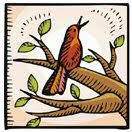Proper trimming helps damaged trees recover.
Today, I read several articles in the national news about tree damage in recent snow and ice storms. I feel a lot of empathy for the tree-owners, because I know how storms can wreak havoc on trees. About ten years ago, we had two severe ice storms back-to-back that did a tremendous amount of damage to our trees.
When cleaning up the mess, considerable pruning of the broken trees will probably be necessary. It's important for the health of the trees to cut any broken limbs cleanly using good pruning techniques.
If you use the correct method of removing a limb you won't rip any bark off the stem of the tree in the process. Be sure you know how to properly remove a limb before you go near your trees with a saw! Here is a good guide with clear diagrams on best limb removal practices: Landscape Manual of Louisa County, Virginia.
It's certainly best to hire a trained and certified arborist to do the pruning after storm damage, but in real life, you may not be able to find or afford a specialist. Maybe you'll decide to hire a chainsaw crew that has come into the area seeking work, or maybe you'll try to do some of the pruning yourself (be very careful!)
Be sure that any chainsaw crew you hire has insurance. And no matter who you get to do your tree pruning, you need to know exactly what you want cut and supervise the workers while they are doing it. Don't assume that the workers know proper tree pruning just because they can climb a tree. Don't hesitate to be really bossy about how you want the branches trimmed!
Whatever you do, don't top your trees! Properly pruned trees will usually recover from storm damage without being permanently deformed, but topped trees will look terrible for the rest of their shortened lifespans! Tree trimmers often push homeowners to do a "good topping", but that's an oxymoron. In my humble opinion, it would be better for your storm-damaged trees to have no pruning at all than to top them!
 And one last thing -- try not to be disheartened. If you had seen the sickening sight of our terribly broken trees after the storms, you would be amazed how they recovered, after careful pruning, to be healthy, attractive trees today.
And one last thing -- try not to be disheartened. If you had seen the sickening sight of our terribly broken trees after the storms, you would be amazed how they recovered, after careful pruning, to be healthy, attractive trees today.


 "The power to recognize trees at a glance without examining their leaves or flowers or fruit as they are seen, for example, from the car-window during a railroad journey, can only be acquired by studying them as they grow under all possible conditions over wide areas of territory. Such an attainment may not have much practical value, but once acquired it gives to the possessor a good deal of pleasure which is denied to less fortunate travelers."
"The power to recognize trees at a glance without examining their leaves or flowers or fruit as they are seen, for example, from the car-window during a railroad journey, can only be acquired by studying them as they grow under all possible conditions over wide areas of territory. Such an attainment may not have much practical value, but once acquired it gives to the possessor a good deal of pleasure which is denied to less fortunate travelers."
1 comments -- please add yours:
You should (NOT!) see some of the hideous tree toppings done around here. It's sickening.
Post a Comment